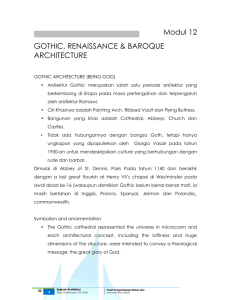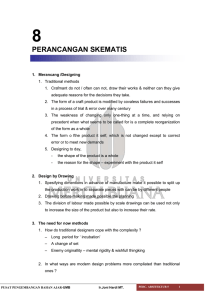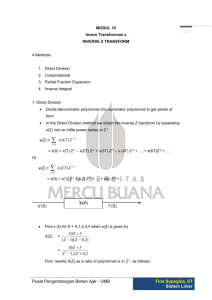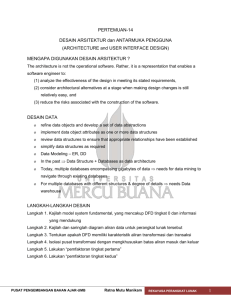Modul 11
advertisement
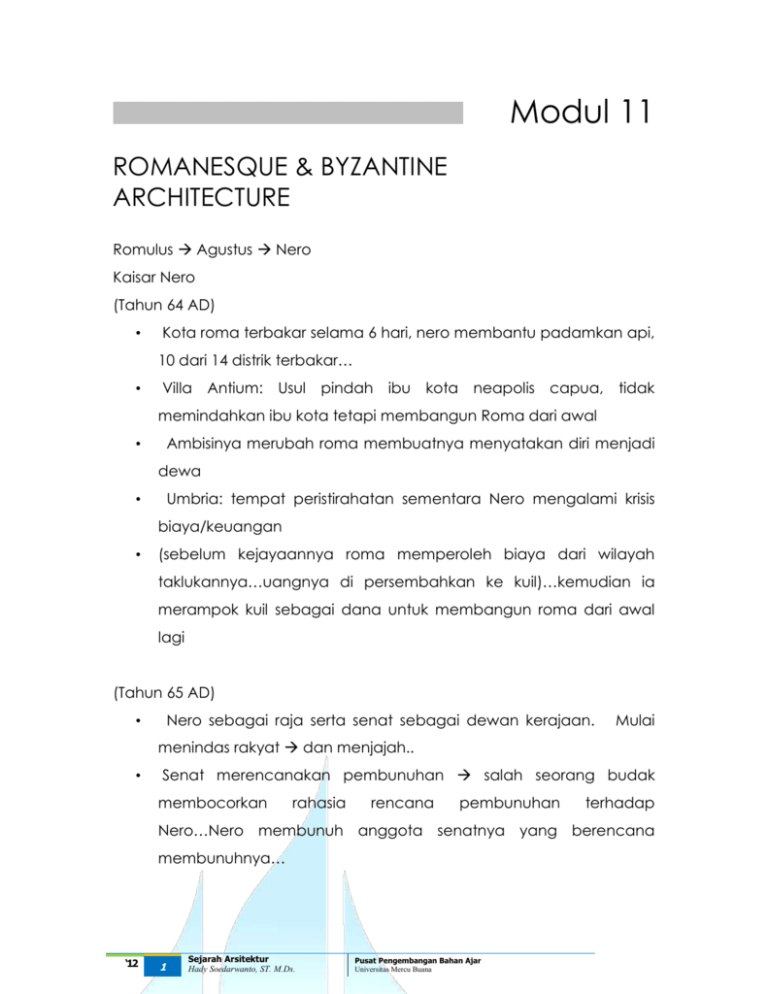
Modul 11
ROMANESQUE & BYZANTINE
ARCHITECTURE
Romulus Agustus Nero
Kaisar Nero
(Tahun 64 AD)
•
Kota roma terbakar selama 6 hari, nero membantu padamkan api,
10 dari 14 distrik terbakar…
•
Villa Antium: Usul
pindah ibu kota
neapolis capua,
tidak
memindahkan ibu kota tetapi membangun Roma dari awal
Ambisinya merubah roma membuatnya menyatakan diri menjadi
•
dewa
Umbria: tempat peristirahatan sementara Nero mengalami krisis
•
biaya/keuangan
•
(sebelum kejayaannya roma memperoleh biaya dari wilayah
taklukannya…uangnya di persembahkan ke kuil)…kemudian ia
merampok kuil sebagai dana untuk membangun roma dari awal
lagi
(Tahun 65 AD)
Nero sebagai raja serta senat sebagai dewan kerajaan.
•
Mulai
menindas rakyat dan menjajah..
•
Senat merencanakan pembunuhan salah seorang budak
membocorkan
rahasia
rencana
pembunuhan
terhadap
Nero…Nero membunuh anggota senatnya yang berencana
membunuhnya…
‘12
1
Sejarah Arsitektur
Hady Soedarwanto, ST. M.Ds.
Pusat Pengembangan Bahan Ajar
Universitas Mercu Buana
Beliau menyelengarakan festifal seni…dengan dirinya sebagai
•
bintang utama,,,hanya karena kesalahan kecil ketika pertunjukkan
ia membunuh istrinya (poppaea) sendiri yang sedang hamil…Roma
bangkrut…
(Tahun 66 AD)
•
Nero goes to Greek to party…biaya dari kaum kaya dengan
merampas kekayaan mereka…
•
dia
menjadikan
budak
laki2nya
menjadi
wanita
dan
menjadikannya istrinya…poppaea…gelombang bunih diri
(Tahun 67 AD)
•
Pemberontakan…Galia afrika, germania dan spanyol berontak
…dan bangsawan romawi…
(Tahun 68 AD)
•
Nero kembali ke Roma dengan kota yang sudah selesai…nero
membentuk pasukan dari para pelacur yang di potong rambutnya
sampai pendek
•
Para
pengawal
meninggalkan
istana…
Nero
bunuh
diri,
berakhirnya raja dari garis keturunan.
Constantine VS maxentius
(Tahun 312AD)
•
Romawi menjadi sangat besar…Negara berkembang 2 di barat
dan
2
di
Timur
dan
ada
satu
orang
yang
dapat
menyatukannya…Constantine… Agama Kristen sebagai agama
Romawi…terjadi perbedaan pendapat
dengan kepercayaan
dewa-dewi…Dimulai pembangunan gereja-gereja…musuh takut
akan lambing constatine karena ketakutan mengandung daya
magis…
‘12
2
Sejarah Arsitektur
Hady Soedarwanto, ST. M.Ds.
Pusat Pengembangan Bahan Ajar
Universitas Mercu Buana
The Fall of Rome (410 AD)
•
Barbarian: Goth (King Alaric), The Hun
•
Empiere Honorius
•
476 AD west was ambush
•
In the east still, Byzantium-constantinople
BUILDING IN ROMAN
Alyscamps, a necropolis in Arles
Amphitheatre
Roman Forum
Aqueduct
Basilica
Catacombs of Rome
Circus Maximus
Curia Hostilia (Senate House), in Rome
Domus
Domus Aurea (former building)
Insulae
Maison Carrée
Pantheon
Roman bridge
Roman lighthouse
Roman road
Roman theatre
Roman villa
Hadrian's Wall
Temple (Roman)
Thermae
Trajan's Column
‘12
3
Sejarah Arsitektur
Hady Soedarwanto, ST. M.Ds.
Pusat Pengembangan Bahan Ajar
Universitas Mercu Buana
Triumphal arch
The Alyscamps is a large Roman necropolis a short distance outside the
walls of the old town of Arles, France. It was one of the most famous
necropolises of the ancient world. The name is a corruption of the Latin
Elisii Campi, or Elysian Fields.
The Amphithetre
•
The name amphitheatre is given to a public building of the Classical
period (being particularly associated with ancient Rome) which
was used for spectator sports, games and displays.
•
Apart from function, the important outward distinction between an
amphitheatre and a theatre is that an amphitheatre is round or oval
in shape (whereas a classical theatre was semi-circular).
•
However, an amphitheatre differs from a circus, which was used for
racing and looked more like a very long, narrow horse shoe.
•
The best-known amphitheatre in the world is the Colosseum in Rome
The Coloseum
•
Brings together the violence and the achievements of Roman
society
•
Home of gladiatorial contests… man vs.man, man vs. animal,
animal vs. animal
•
Seating designed for comfort with an expandable covering over
the top
•
Plumbing which could wash away the blood or create an ‘inland
sea’ on which to have mock sea battles
‘12
4
Sejarah Arsitektur
Hady Soedarwanto, ST. M.Ds.
Pusat Pengembangan Bahan Ajar
Universitas Mercu Buana
Roman aqueducts were extremely sophisticated constructions. They were
built to remarkably fine tolerances, and of a technological standard that
had a gradient of only 34 cm per km (1:3,000), descending only 17 m
vertically in its entire length of 31 miles (50 km). Powered entirely by
gravity, they transported very large amounts of water very efficiently (the
Pont du Gard carried 20,000 cubic meters {nearly 6 million gallons} a day
and the combined aqueducts of the city of Rome supplied around 1
million cubic meters (300 million gallons) a day.
Roman Forum with Palatine Hill in the background.
The arch at the front left is the Arch of Septimius Severus, while on the right
the three-columned Temple of Vespasian and Titus stands in front of the
Temple of Saturn.
The Roman Forum was the central area around which ancient Rome
developed, in which commerce, business, prostitution, cult and the
administration of justice took place.
‘12
5
Sejarah Arsitektur
Hady Soedarwanto, ST. M.Ds.
Pusat Pengembangan Bahan Ajar
Universitas Mercu Buana
Here the communal hearth was located. Sequences of remains of paving
show that sediment eroded from the surrounding hills was already raising
the level of the forum in early Republican times.
Temple of Castor and Pollux
Temple of Romulus
Temple of Saturn
Temple of Vesta
Temple of Venus and Roma
Basilica Aemilia
Basilica Julia
Arch of Septimius Severus
Arch of Titus
Rostra,
Curia Hostilia,
Roman Senate.
Basilica of Maxentius
Constantine
Tabularium
Basilicas in the Roman Forum
Porcian Basilica, built by Cato the Elder during the time he was censor
Aemilian Basilica, built by the censor Aemilius Lepidus in 179 BC, Julian
Basilica, completed by Augustus. Basilica Opimia, erected probably by
the consul L. Opimius in 121 BC, at the same time that he restored the
temple of Concord. Basilica Sempronia, built by the censor Marcus
Sempronius Gracchus in 169 BC
The Circus Maximus is a park today. The building on the back is the
imperial palace on the Palatine.
Map of downtown Rome during the
Roman Empire, with Circus Maximus at the lower right corner.
•
The Circus Maximus (Latin for largest arena) is an ancient arena
and mass entertainment venue located in Rome.
•
Situated in the valley between the Aventine and Palatine hills the
location was first utilised for public games and entertainment by the
Etruscan kings of Rome.
‘12
6
Sejarah Arsitektur
Hady Soedarwanto, ST. M.Ds.
Pusat Pengembangan Bahan Ajar
Universitas Mercu Buana
•
Julius Caesar expanded the Circus around 50 BC, after which the
track measured approximately 600 metres in length, 225 metres in
breadth and could accommodate an estimated 250,000 seated
spectators
•
The most important event at the Circus was chariot racing. The
track could hold 12 chariots
•
To allow the chariots to line up to begin the race. Here there were
starting gates, or carceres, which staggered the chariots so that
each travelled the same distance to the first turn.
Insulae
•
In Roman architecture, insulae were large apartment buildings
where the lower and middle classes of Romans (the plebs) dwelled.
•
The floor at ground level was used for, shops and businesses with
living space on the higher floors.
•
Private houses were therefore a luxury only the wealthy could
afford. This led a majority of the inhabitants of the inner city to live in
apartment and tenement housing called insulae.
•
A single insulae could acomodate over 40 people in only 400
square meters
•
Because of the dangers of fire, and collapse, the height of the
insulae were restricted by Emperor Augustus to 70 feet, and again
by Emperor Nero down to 60 feet after the Great fire of Rome.
There may have been up to 50,000 insulaes, as compared to only
•
2000 domus in the late 200 A.D, when the city was in decline, and
the population was smaller.
•
Unlike upperclass homes, most insulae did not have running water
or sanitation, with the inhabitants relying on public toilets and
fountains.
‘12
7
Sejarah Arsitektur
Hady Soedarwanto, ST. M.Ds.
Pusat Pengembangan Bahan Ajar
Universitas Mercu Buana
•
The name of the "insulae" was derived from the Latin for islands.
They were called so because of the way they looked from a birds
eye view. It would appear these buildings were spaced out like
islands (hence the name), while being surrounded by road.
Pantheon
The Pantheon is a building in Rome which was originally built as a temple
to the seven deities of the seven planets in the state religion of Ancient
Rome, but which has been a Christian church since the 7th century.
A
r
c
h
i
t
e
c
of Damascus.
‘12
8
Sejarah Arsitektur
Hady Soedarwanto, ST. M.Ds.
Pusat Pengembangan Bahan Ajar
Universitas Mercu Buana
t
Apollodorus
A Roman bridge in Vaison la Romaine, France. Roman bridges, built by
ancient Romans, were the first large and lasting bridges built.
Roman
bridges were built with stone and had the arch as its basic structure. Most
utilized concrete as well.
Ancient Roman lighthouses
Lighthouses in ancient times
•
Before the development of clearly defined ports, mariners were
guided by fires built on hilltops.
•
Since raising the fire would improve the visibility, placing the fire on
a platform became a practice that led to the development of the
lighthouse. In antiquity, the lighthouse functioned more as an
entrance marker to ports than as a warning signal for reefs and
promontories, unlike many modern lighthouses.
•
Most show a building with two or three stories that decreases in
width as it ascends. The limited size of coins could cause the
producer of the coin to alter the image to fit on the surface.
•
The
similarity
in
depictions
of
lighthouses
suggests
a
conventionalization of details rather than accurate representations
of specific beacons. None of these media provide information
about the interior placement of stairs and ramps in the buildings.
Hadrian's Wall (Vallum Hadriani) was a stone and turf fortification built
by the Roman Empire across the width of Great Britain to prevent
military raids by the tribes of Scotland to the north.
To improve economic stability and provide peaceful conditions in the
Roman province of Britannia to the south, to define the frontier of the
Empire physically, and to separate the unruly Selgovae tribe in the
‘12
9
Sejarah Arsitektur
Hady Soedarwanto, ST. M.Ds.
Pusat Pengembangan Bahan Ajar
Universitas Mercu Buana
north from the Brigantes in the south and discourage them from
uniting.
The name is also sometimes used jocularly as a synonym for the border
between Scotland and England, although for most of its length the wall
follows a line well south of the modern border
The wall was the northern border of the Empire in Britain for most of the
Roman Empire's rule, and also the most heavily fortified border in the
Empire. In addition to its use as a military fortification, it is thought that
the gates through the wall would also have served as customs posts to
allow trade taxation.
Thermae
•
Roman public baths in Bath, England.a The loss of the original roof
has encouraged green algae growth.
•
The term thermae was the word the ancient Romans used for the
buildings housing their public baths.
•
Most Roman cities had at least one, if not many, such buildings,
which were centers of public bathing and socialization. Upper-class
Romans would usually visit daily, lower-class people about once a
week.
Baths in culture and society
•
Of all the leisure activities, bathing was the most important for
ancient Romans.
•
since it was part of the daily regimen for men of all classes, and
many women as well.
•
Although wealthy Romans might set up a bath in their town houses
or in their country villas, heating a series of rooms or even a
separate building especially for this purpose, they still often
‘12
10
Sejarah Arsitektur
Hady Soedarwanto, ST. M.Ds.
Pusat Pengembangan Bahan Ajar
Universitas Mercu Buana
frequented the numerous public bathhouses in the cities and towns
throughout the empire.
•
Small bathhouses, called balneum, might be privately owned, but
they were public in the sense that they were open to the populace
for a fee.
•
The large baths, called thermae, were owned by the state and
often covered several city blocks.
•
The largest of these, the Baths of Diocletian, could hold up to 3,000
bathers. Fees for both types of baths were quite reasonable, within
the budget of most free Roman males.
•
Since the Roman workday began at sunrise, work was usually over
a little after noon. Around three in the afternoon, men would go to
the baths and stay for several hours of sport, bathing, and
conversation, after which they would be ready for a relaxing dinner.
•
Republican bathhouses often had separate bathing facilities for
women and men, but by the time of the empire the custom was to
open the bathhouses to women during the early part of the day
and reserve it for men from two in the afternoon until closing time.
•
Which was usually Certainly women who were concerned about
their respectability did not frequent the baths when the men were
there, but of course the baths were an excellent place for
prostitutes to work.
‘12
11
Sejarah Arsitektur
Hady Soedarwanto, ST. M.Ds.
Pusat Pengembangan Bahan Ajar
Universitas Mercu Buana
A triumphal arch is a structure in the shape of a monumental archway,
usually built to celebrate a victory in war.
The arch is invariably a free-standing structure, quite separate from
city gates or walls.
In its simplest form a triumphal arch consists of two pillars connected
by an arch, crowned with a superstructure or attic on which a statue
might be mounted or which bears commemorative inscriptions.
More elaborate triumphal arches have more than one archway,
typically three or five of varying sizes.
BYZANTINE ARCHITECTURE
Byzantine architecture is the architecture of the Byzantine Empire. The
empire emerged gradually after AD 330, when Constantine moved the
capital of the Roman Empire to Byzantium, which was later renamed
Constantinople and is now Istanbul.
Early architecture
Prime examples of early Byzantine architecture date from Justinian I's reign
and survive in Ravenna and Constantinople. One of the great
breakthroughs in the history of Western architecture occurred when
Justinian's architects invented a complex system providing for a smooth
transition from a square plan of the church to a circular dome (or domes)
by means of squinches or pendentives.
In Ravenna, we have the longitudinal basilicas of San Vitale and S
Apollinare Nuovo, among others. Justinian's monuments in Constantinople
include the domed churches of Hagia Sophia and Hagia Irene, but there
is also an earlier, smaller church of Sts Sergius and Bacchus (sometimes
referred to as "Little Hagia Sophia"), which might have served as a model
for both in that it combined the elements of a longitudinal basilica with
those of a centralized building.
‘12
12
Sejarah Arsitektur
Hady Soedarwanto, ST. M.Ds.
Pusat Pengembangan Bahan Ajar
Universitas Mercu Buana
Secular structures include the ruins of the Great Palace of Constantinople,
the innovative walls of Constantinople (with 192 towers) and Basilica
Cistern (with hundreds of recycled classical columns). A frieze in the
Ostrogothic palace in Ravenna depicts an early Byzantine palace.
Hagios Demetrios in Thessaloniki, St Catherine Monastery on Mount Sinai,
Djvari in present-day Georgia, and three Armenian churches of
Echmiadzin all date primarily from the 7th century and provide a glimpse
on architectural developments in the Byzantine provinces following the
age of Justinian.
Middle period
The Middle period of Byzantine history didn't see any ambitious
architectural undertakings. From the years of Iconoclasm we have only
the Church of Hagia Sophia, Thessaloniki. Another major building, the
Assumption church in Nicaea, was destroyed in the 1920s, although the
photographs survive.
The period of the Macedonian dynasty, traditionally considered the
epitome of Byzantine art, has not left a lasting legacy in architecture. It is
presumed that Basil I's votive church of the Theotokos of Phoros (not
longer extant) served as a model for most cross-in-square sanctuaries of
the period, including the monastery church of Hosios Lukas in Greece (ca.
‘12
13
Sejarah Arsitektur
Hady Soedarwanto, ST. M.Ds.
Pusat Pengembangan Bahan Ajar
Universitas Mercu Buana
1000), Nea Moni Katholikon in Chios (a pet project of Constantine IX), and
the Daphnion near Athens (ca. 1050).
Comnenan and Paleologan periods
In Constantinople and Asia Minor the architecture of the Comnenan
period is almost non-existant, with the notable exception of the Elmali
Kilise and other rock sanctuaries of Cappadocia. Much architecture
survives on the outskirts of the Byzantine world, where the national forms of
architecture came into being: in the Transcaucasian countries, in Russia,
Bulgaria, Serbia, and other Slavic lands; and also in Sicily (Cappella
Palatina) and Veneto (St Mark's Basilica, Torcello Cathedral).
The Paleologan period is well-represented in a dozen churches of
Constantinople, notably St Saviour at Chora and St Mary Pammakaristos
(illustrated, to the right). Unlike their Slavic counterparts, the Paleologan
architects never accented the vertical thrust of structures. As a result,
there is little grandeur in the late medieval architecture of Byzantium
(barring the Hagia Sophia of Trapezunt).
‘12
14
Sejarah Arsitektur
Hady Soedarwanto, ST. M.Ds.
Pusat Pengembangan Bahan Ajar
Universitas Mercu Buana
The church of Holy Apostles in Thessaloniki is often cited as an archetypal
structure of the late period, when the exterior walls were intricately
decorated with complex brickwork patterns or with glazed ceramics.
Other churches from the years immediately predating the fall of
Constantinople survive on Mount Athos and in Mistra (e.g., Brontocheion
monastery).
Structural evolution
As early as the building of Constantine's churches in Palestine there were
two chief types of plan in use: the basilican, or axial, type, represented by
the basilica at the Holy Sepulchre, and the circular, or central, type,
represented by the great octagonal church once at Antioch. Those of the
latter type we must suppose were nearly always vaulted, for a central
dome would seem to furnish their very raison d'etre. The central space
was sometimes surrounded by a very thick wall, in which deep recesses, to
the interior, were formed, as at the noble church of St George, Salonica
(5th century), or by a vaulted aisle, as at Sta Costanza, Rome (4th
century); or annexes were thrown out from the central space in such a
way as to form a cross, in which these additions helped to counterpoise
the central vault, as at the Mausoleum of Galla Placidia, Ravenna (5th
century).
‘12
15
Sejarah Arsitektur
Hady Soedarwanto, ST. M.Ds.
Pusat Pengembangan Bahan Ajar
Universitas Mercu Buana
The most famous church of this type was that of the Holy Apostles,
Constantinople. Vaults appear to have been early applied to the
basilican type of plan; for instance, at Hagia Irene, Constantinople (6th
century), the long body of the church is covered by two domes.
Byzantine legacy
Ultimately, Byzantine architecture in the West gave way to Romanesque
and Gothic architecture. In the East it exerted a profound influence on
early Islamic architecture, with notable examples including the Umayyad
Great Mosque of Damascus and the Dome of the Rock in Jerusalem,
which required Byzantine craftsmen and mosaicists to decorate. In Russia,
Romania,
Georgia,
and
other
Orthodox
countries
the
Byzantine
architecture persisted even longer, finally giving birth to local schools of
architecture.
Legacy
The Byzantine era properly defined came to an end with the fall of
Constantinople to the Ottoman Turks in 1453, but by this time the
Byzantine cultural heritage had been widely diffused, carried by the
spread of Orthodox Christianity, to Bulgaria, Serbia, Romania and, most
importantly, to Russia, which became the centre of the Orthodox world
following the Ottoman conquest of the Balkans. Even under Ottoman rule,
Byzantine traditions in icon-painting and other small-scale arts survived.
The influence of Byzantine art in western Europe, particularly Italy, was
seen in ecclesiastical architecture, through the development of the
Romanesque style in the 10th century and 11th centuries. This influence
was transmitted through the Frankish and Salic emperors, primarily
Charlemagne, who had close relations with Byzantium.
‘12
16
Sejarah Arsitektur
Hady Soedarwanto, ST. M.Ds.
Pusat Pengembangan Bahan Ajar
Universitas Mercu Buana
